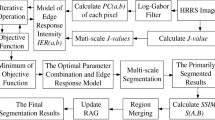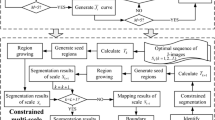Abstract
This paper proposes a multi-scale segmentation approach for high resolution remote sensing image (HRRSI) based on the gravitational field and region merging. In this approach, the HRRSI is firstly transformed into a gravitational field by incorporating the spatial and spectral information. Based on which, the attraction among neighboring pixels will cause travelling of each pixel. During the travelling, pixels with similar spectral information which are at the nearby location get grouped, which define an initial segmentation for the HRRSI which is often over-segmented in places. Then, an improved graph based region merging method is adopted to merge the over-segmented regions which yield the multi-scale segmentation results. To evaluate the proposed approach, we conduct extensive experiments on three HRRSIs from different sensors and the obtained results are compared with those of eCognition’s multi-resolution segmentation method. The experimental results show that the proposed approach reduces much more over-segmentation problem and produces more accurate image segmentation.






Similar content being viewed by others
References
Akcay HG, Aksoy S (2008) Automatic detection of geospatial objects using multiple hierarchical segmentations. IEEE Transactions on Geoscience and Remote Sensing 46:2097–2111
Arbelaez P, Maire M, Fowlkes C et al (2011) Contour detection and hierarchical image segmentation. IEEE transactions on pattern analysis and machine intelligence 33:898–916
Banerjee B, Varma S, Buddhiraju KM et al (2014) Unsupervised multi-spectral satellite image segmentation combining modified mean-shift and a new minimum spanning tree based clustering technique. IEEE Journal of Selected Topics in Applied Earth Observations and Remote Sensing 7:888–894
Beaulieu JM, Goldberg M (1989) Hierarchy in picture segmentation: a stepwise optimization approach. IEEE Trans Pattern Analysis and Machine Intelligence 11:150–163
Benz UC, Hofmann P, Willhauck G et al (2004) Multi-resolution, object-oriented fuzzy analysis of remote sensing data for GIS-ready information. ISPRS Journal of Photogrammetry and Remote Sensing 58:239–258
Bruzzone L, Carlin L (2006) A multilevel context-based system for classification of very high spatial resolution images. IEEE transactions on Geoscience and Remote Sensing 44:2587–2600
Carleer A, Wolff E (2006) Urban land cover multi-level region-based classification of VHR data by selecting relevant features. International Journal of Remote Sensing 27:1035–1051
Chabrier S, Emile B, Rosenberger C et al (2006) Unsupervised performance evaluation of image segmentation. EURASIP Journal on Applied Signal Processing 2006:217–217
de Wit A, Clevers J (2004) Efficiency and accuracy of per-field classification for operational crop mapping. International journal of remote sensing 25:4091–4112
Gaetano R, Scarpa G, Poggi G (2009) Hierarchical texture-based segmentation of multiresolution remote-sensing images. IEEE Transactions on Geoscience and Remote Sensing 47:2129–2141
Grau V, Mewes A, Alcaniz M et al (2004) Improved watershed transform for medical image segmentation using prior information. IEEE Transactions on Medical Imaging 23:447–458
Haris K, Efstratiadis SN, Maglaveras N et al (1998) Hybrid image segmentation using watersheds and fast region merging. IEEE Transactions on image processing 7:1684–1699
Hay GJ, Blaschke T, Marceau DJ et al (2003) A comparison of three image-object methods for the multiscale analysis of landscape structure. ISPRS Journal of Photogrammetry and Remote Sensing 57:327–345
Huang Z, Zhang J, Li X, Zhang H (2014) Remote sensing image segmentation based on dynamic statistical region merging. Optik-International Journal for Light and Electron Optics 125:870–875
Ilc N, Dobnikar A (2012) Generation of a clustering ensemble based on a gravitational self-organising map. Neurocomputing 96:47–56
Jain PK, Susan S (2013) An adaptive single seed based region growing algorithm for color image segmentation. In: A Jagatia, VR Rao, S Doolla (eds) Proceeding of 2013 Annual IEEE India Conference (INDICON), Mumbai, India, pp 1–6
Johnson B, Xie Z (2011) Unsupervised image segmentation evaluation and refinement using a multi-scale approach. ISPRS Journal of Photogrammetry and Remote Sensing 66:473–483
Karl JW, Maurer BA (2010) Multivariate correlations between imagery and field measurements across scales: comparing pixel aggregation and image segmentation. Landscape Ecology 25:591–605
Laben CA, Brower BV Process for enhancing the spatial resolution of multispectral imagery using pan-sharpening, 2000. U.S. Patent Office.
Liu J, Li P, Wang X (2015) A new segmentation method for very high resolution imagery using spectral and morphological information. ISPRS Journal of Photogrammetry and Remote Sensing 101:145–162
Moreno R, Graña M (2014) Segmentation of hyperspectral images by tuned chromatic watershed. In: Recent advances in knowledge-based paradigms and applications. Springer International Publishing, pp 103–113
Nazif AM, Levine MD (1984) Low level image segmentation: an expert system. IEEE Transactions on Pattern Analysis and Machine Intelligence 5:555–577
Nock R, Nielsen F (2004) Statistical region merging. IEEE Trans Pattern Analysis and Machine Intelligence 26:1452–1458
Rashedi E, Nezamabadi-Pour H (2013) A stochastic gravitational approach to feature based color image segmentation. Engineering Applications of Artificial Intelligence 26:1322–1332.
Rashedi E, Nezamabadi-Pour H, Saryazdi S (2009) GSA: a gravitational search algorithm. Information Sciences 179:2232–2248
Rezvanifar A, Khosravifard M (2015) Including the size of regions in image segmentation by region-based graph. IEEE Transactions on Image Processing 23:635–644
Sen D, Pal SK (2012) Improving feature space based image segmentation via density modification. Information Sciences 191:169–191
Sun G, Liu Q, Liu Q et al (2007) A novel approach for edge detection based on the theory of universal gravity. Pattern Recognition 40:2766–2775
Tabb M, Ahuja N (1997) Multiscale image segmentation by integrated edge and region detection. IEEE Trans Image Processing 6:642–655
Tilton JC, Tarabalka Y, Montesano PM, Gofman E (2012) Best merge region-growing segmentation with integrated nonadjacent region object aggregation. IEEE Transactions on Geoscience and Remote Sensing 50:4454–4467
Tzotsos A, Argialas D (2006) MSEG: a generic region-based multi-scale image segmentation algorithm for remote sensing imagery. In: Proceedings of ASPRS 2006 Annual Conference, Reno, Nevada.
Vincent L, Soille P (1991) Watersheds in digital spaces: an efficient algorithm based on immersion simulations. IEEE Transactions on Pattern Analysis and Machine Intelligence 13:583–598
Wright WE (1977) Gravitational clustering. Pattern Recognition 9:151–166
Wu T (2014) Image data field-based framework for image thresholding. Optics & Laser Technology 62:1–11
Yuan J, Wang D, Li R (2014) Remote sensing image segmentation by combining spectral and texture features. IEEE Transactions on Geoscience and Remote Sensing 52:16–24
Zhang X, Xiao P, Feng X et al (2014) Hybrid region merging method for segmentation of high-resolution remote sensing images. ISPRS Journal of Photogrammetry and Remote Sensing 98:19–28
Zhao J, Jia M (2015) Segmentation algorithm for small targets based on improved data field and fuzzy c-means clustering. Optik 126:4330–4336
Acknowledgements
This work is funded by Chinese Natural Science Foundation Projects (41471353).
Author information
Authors and Affiliations
Corresponding authors
Rights and permissions
About this article
Cite this article
Zhang, A.Z., Sun, G.Y., Liu, S.H. et al. Multi-scale segmentation of very high resolution remote sensing image based on gravitational field and optimized region merging. Multimed Tools Appl 76, 15105–15122 (2017). https://doi.org/10.1007/s11042-017-4558-4
Received:
Revised:
Accepted:
Published:
Issue Date:
DOI: https://doi.org/10.1007/s11042-017-4558-4




